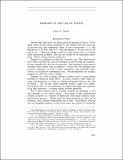Property as the Law of Things

View/
Author
Published Version
http://www.harvardlawreview.org/media/pdf/vol125_h.smith.pdfMetadata
Show full item recordCitation
Henry E. Smith, Property as the Law of Things, 125 Harv. L. Rev. 1691 (2012).Abstract
The New Private Law takes seriously the need for baselines in general and the traditional ones furnished by the law in particular. One such baseline is the “things” of property. The bundle of rights picture popularized by the Legal Realists downplayed things and promoted the expectation that features of property are detachable and tailorable without limit. The bundle picture captures too much to be a theory. By contrast, the information cost, or architectural, theory proposed here captures how the features of property work together to achieve property’s purposes. Drawing on Herbert Simon’s notions of nearly decomposable systems and modularity, the article shows how property employs a thing-based exclusion-governance architecture to manage complexity of the interactions between legal actors. Modular property first breaks this system of interactions into components, and this begins with defining the modular things of property. Property then specifies the interface between the modular components of property through governance strategies that make more direct reference to uses and purposes, as in the law of nuisance, covenants, and zoning. In contrast to the bundle of rights picture, the modular theory captures how a great number of features of property – ranging from in-rem-ness, the right to exclude, and the residual claim, through alienability, persistence, and compatibility, and beyond to deep aspects like recursiveness, scalability, and resilience – follow from the modular architecture. The Article then shows how the information cost theory helps explain some puzzling phenomena such as the pedis possessio in mining law, fencing in and fencing out, the unit rule in eminent domain, and the intersection of state action and the enforcement of covenants. The Article concludes with some implications of property as a law of modular things for the architecture of private law.Terms of Use
This article is made available under the terms and conditions applicable to Open Access Policy Articles, as set forth at http://nrs.harvard.edu/urn-3:HUL.InstRepos:dash.current.terms-of-use#OAPCitable link to this page
http://nrs.harvard.edu/urn-3:HUL.InstRepos:11223965
Collections
- HLS Scholarly Articles [1913]
Contact administrator regarding this item (to report mistakes or request changes)


